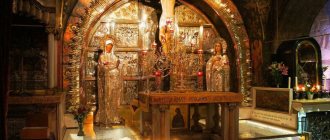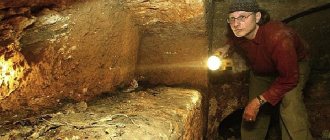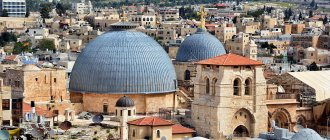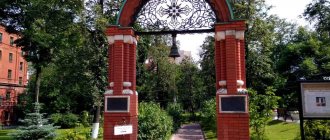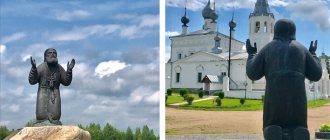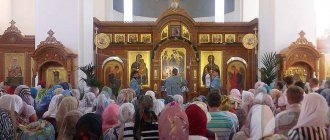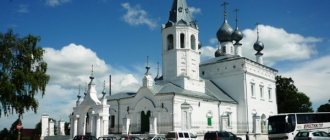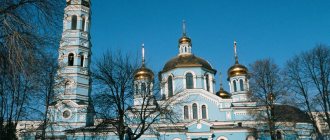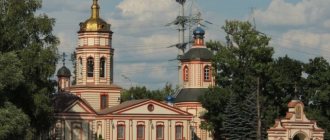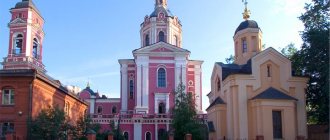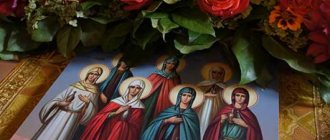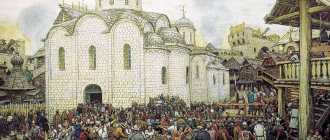The Church of the Holy Sepulcher (Church of the Resurrection of Christ) is a Jerusalem temple, a complex of buildings erected on the site of the crucifixion, burial and resurrection of Jesus Christ, the main shrine, and since the 4th century a place of pilgrimage for Christians around the world.
The last 5 stations of the Way of the Cross of Jesus to the place of execution are located under the arches of the Church of the Holy Sepulchre, which is located in the Old City of Jerusalem, in the Christian Quarter. The complex of religious buildings is the headquarters of the Jerusalem Orthodox Church.
A look through the centuries
The site of the crucifixion, burial and resurrection of Jesus Christ was preserved and revered by early Christians. During the time of Emperor Constantine the Great, when Christianity in Rome acquired the status of a state religion, the first Christian church .
In 325, the mother of Constantine I, 80-year-old Helen, after a dream in which she was commanded to “go from Rome to Jerusalem and bring to light the places closed by the wicked,” began a search for the Cave of the Holy Sepulcher. A local resident helped Elena find the cave and find the Life-Giving Cross. At the site of the finds, the first Church of the Holy Sepulcher was founded, which was solemnly consecrated on September 13, 335 in the presence of Emperor Constantine and clergy from different countries.
At the beginning of the 11th century, the Church of the Resurrection of Christ was destroyed by order of the Egyptian Caliph Al-Hakim-Amrullah. It took half a century to reconstruct the shrine at the direction of the Byzantine ruler Constantine Monomakh. The temple suffered pogroms, fires and natural disasters.
The fire of 1808 changed the appearance of the temple, and the earthquakes of 1545 and 1927 seriously destroyed it. At the beginning of the 20th century, the building was strengthened with steel structures and decorated with new frescoes. The Church of the Holy Sepulcher remains in this form to this day.
Historical facts
The burial place of Christ has been revered since ancient times; we can say that even the very first Christians considered this place to be the holiest. Even during the construction of a huge church by Constantine I, his mother Elena carried out excavations, with the help of which they managed to obtain the Holy Sepulcher, nails and three crosses.
The Edicule in all the photos is presented in its most beautiful form, but few people know that the old building was destroyed in a fire that happened in 1808. Already in 1810, a new structure was built, which retains its appearance to this day. When renovating the building, the parameters of the cuvuklia, which is located in the Resurrection New Jerusalem Monastery, were taken as a basis. Unfortunately, in 1927, due to an earthquake, the condition of the structure was damaged. This event led to the fact that the building had to be strengthened along the side walls with beams. Thus, today pilgrims all over the world have the opportunity to venerate this landmark.
Excursions in Israel
- $60
Jerusalem of 3 religions - $65
Christian Jerusalem
- $50
Jerusalem panoramic view, Yad Vashem
Complex of the Church of the Holy Sepulcher
The Church of the Resurrection of Christ is huge and majestic. The chapels associated with the moments of Christ's crucifixion preserve an atmosphere of holiness. The complex of the Church of the Holy Sepulcher includes:
- Katholikon is an Orthodox church within a church.
- The Holy Sepulcher is the burial place of the Savior and the main altar.
- Golgotha is the hill where Jesus Christ was crucified.
- Edicule – chapel in the Rotunda.
- The stone of anointing is a consecrated copy of the slab on which Jesus was laid when he was taken down from the cross.
The temple is divided between 6 denominations of the Christian Church: Greek Orthodox, Catholic, Armenian, Coptic, Syriac and Ethiopian. Each is allocated chapels and hours for prayer.
In order to avoid discord between faiths, according to tradition, the keys to the main entrance have been given to the Arab family of Judy for permanent storage since 638, and the right to open the entrance with these keys every day is given to the Nuseib family. For nine centuries the privilege has been passed on from father to son.
Aisles of the complex:
- The chapel of Adam with his head, onto which, during the crucifixion, the most pure blood of the Savior, pouring through a cleft in the rock, washed away Adam’s sin. Therefore, on Golgotha, a skull is depicted at the bottom of the crucifix.
- The chapel of the Crown of Thorns with the crown placed in Pretoria on the head of Jesus Christ. Under the throne is part of the stone on which the Lord sat when the crown was laid on him.
- The chapel of the discovery of the Life-Giving Cross with the entrance to the Church of St. Helena. At the place where the Cross was found there is a Greek throne . Huge fragments of natural rocks are preserved here in the form in which they remained after the earthquake during the crucifixion of Christ. In memory of the event of the discovery of the Cross, the Orthodox Church established the holiday of the Exaltation of the Cross of the Lord on September 27.
- The chapel of the Separation of the Robe with icons depicting scenes of the division of Christ's robe after the execution. According to the custom of that time, those who crucified Christ divided his clothes by casting lots.
- The chapel of Mary Magdalene with the place of the appearance of the risen Christ marked by a marble circle.
History of the main Christian temple
A holy site outside ancient Jerusalem associated with Jesus Christ was revered by early Christians even after the destruction of the city by the Roman Emperor Titus in 70 and the creation in 135 of the Roman colony Aelia Capitolina by Emperor Hadrian within the boundaries of what is now the Old City. During that period, among other buildings, the Temple of Venus was erected, which was located above the Cave of the Holy Sepulcher.
The first Christian church appeared on the supposed site of Golgotha thanks to the efforts of the mother of Constantine I the Great, Helen. Being already at a fairly advanced age, she decided to go from Rome to Jerusalem, claiming that she had a vision “of divine places closed by the wicked, which she was ordered to bring to light.” According to legend, a local resident helped Elena find the Cave of the Holy Sepulcher, as well as find the Life-Giving Cross and other shrines.
Calvary and Holy Sepulcher, © Yupi666
Built under Constantine I the Great, the Church of the Resurrection was consecrated in 335. The richly decorated complex included:
- the temple-mausoleum of Anastasis with the Holy Sepulcher located in the center under a tent canopy;
- The Great Basilica with an altar facing Anastasis and a crypt (an underground vaulted room) built on the site of the discovery of the Life-Giving Cross.
The buildings stood unchanged for almost three centuries, until the capture of Jerusalem by the Persians in 614. The buildings significantly damaged by them were restored with the participation of the Byzantine emperor by 629, and 8 years later the city was forced to surrender to the army of the Righteous Caliphate on condition of preserving Christian shrines. Four centuries later, the Fatimid caliph broke the treaty and initiated the destruction of Christian churches, accompanied by massacres of believers. As a result, the basilica was irretrievably lost.
Golgotha, © Official website of the Jerusalem Patriarchate
The next stage in the history of the Church of the Holy Sepulcher occurred in the first half of the 11th century, after the Byzantine emperor Constantine VIII, in exchange for the construction of a mosque in Constantinople, managed to agree with another Muslim ruler on the restoration of a Christian shrine in Jerusalem. During that period, several separate chapels and the Church of the Resurrection were built in the form of a rotunda - a cylindrical structure covered with a dome.
The appearance and decoration of the newly built complex was strikingly different from the splendor of the first temple. This injustice was corrected by the crusaders in the middle of the 12th century. They erected a majestic building that united the holy places. It was consecrated in 1149. A five-tier bell tower was also installed, which sank to its present level as a result of the earthquake of 1545.
At the end of the 12th century, after the expulsion of the Crusaders from Jerusalem, Sultan Saladin gave the right to keep the keys to the Church of the Holy Sepulcher and its opening/closing to two different Muslim families of Arab origin. This helped to stop the disputes between the heads of Christian denominations about who should be the first to open the Holy Door. The tradition is still alive - the male representative of the Judeh family keeps the keys, and the male representative of the Nuseibeh family opens/closes the temple. Powers are transferred exclusively by inheritance.
Chapel of Divide, © Official website of the Jerusalem Patriarchate
During the fire of 1808, the Edicule and the tent over Anastasis were damaged. The restoration was carried out by a multinational group of architects. The wooden dome of the Rotunda was replaced with a metal one, giving it its original appearance.
Significant reconstruction was planned to be carried out in the middle of the last century, but due to the outbreak of World War II, the work was postponed to a later date. They started in 1959 and continued in the 1990s and 2010s. In 2013, the belfry was replenished with a bell cast in Russia.
An unprecedented step was taken by the heads of Christian denominations in February 2022. In protest against the decision of the Israeli authorities to levy a city tax on church real estate and transfer part of the church lands to the state, the Church of the Holy Sepulcher was closed indefinitely. The issue was resolved within three days, after which the shrines were reopened to pilgrims.
Stone of Confirmation, © Official website of the Jerusalem Patriarchate
Interior of the temple
The temple is jointly owned and operated by several faiths. In the management of Catholics:
- Altar of Nails.
- Church of the Appearance of the Risen Lord to the Blessed Virgin Mary.
- The northern part of the 2nd tier of the Rotunda and gallery.
- Southern aisle of Golgotha.
- Seat of Magdalene.
- Chapel of the Finding of the Life-Giving Cross.
- Franciscan monastery.
Armenians own:
- Temple of St. Helena.
- 8 columns of Rotona and the southern part of its second tier.
- Throne of the Myrrh-Bearing Women.
- Chapel of the Three Marys.
- Chapel of Vardan.
- Tomb of Joseph of Arimathea.
The western altar of Kulukwiya belongs to the Copts.
Ethiopians own:
- Church of the Four Apostolic Animals.
- The monastery on top of the Church of St. Helena.
The Syrians were given the right to hold services on holidays and weekends in the Armenian chapel of Nicodemus. The Orthodox Church of Jerusalem has overall leadership of the temple, the Kulukwiya and the Katolikon. All faiths take turns holding services at the Holy Sepulcher.
Existing parts
It is worth saying right away that 6 churches share their powers in this shrine, and they also represent three main directions of religion:
- Catholic Church;
- Greek Orthodox;
- Ethiopian;
- Syrian;
- anti-Chalcedonian Armenian;
- Coptic
This distribution has its own rules that all church representatives must follow. Thanks to the historical statute, order in ownership and service is perfectly preserved. It must be clarified that all possessions are strictly negotiated, and no changes are made without notifying church members. As for the common possession, it extends only to the stone of anointing. To understand the essence of this arrangement, it is necessary to consider the three main religions on which this area rests:
- Orthodox Church. It must be said that this direction protects the most important shrines that are located in the temple. It is this church that is the first to begin its services on Holy Saturday. If we consider those parts that belong to her possessions, then these are the Cathedral Church of the Resurrection, the northern chapel of Mount Calvary, one of the tiers of the rotunda, the underground chapel of the Finding of the Cross, the chapel of Adam's Mount, as well as the Virgin of Sorrows;
- Roman Catholic direction. Churches of this direction have authority over such exhibits as the throne of St. Mary Magdalene, the tier of the gallery rotunda, the southern part of Calvary and the underground chapel of the Finding of the Cross (this shrine is divided between the two directions);
- the third direction includes all other churches. This formulation of the question suggests that these churches have their own purposes.
Exterior design
The splendor of the temple corresponds to its high purpose. The main facade is made in the Romanov style . Initially, the entrance was decorated with a marble panel depicting the burial of the Savior and the Entry of the Lord into Jerusalem. Entrance to the temple with two large doors. During Muslim rule, the second door was closed with brickwork.
The left side of the portal is decorated with a white marble column - the Column of the Holy Fire, split by lightning during the first descent of the Holy Fire in 1634 on the holiday of Holy Saturday. On this day, Orthodox and Armenian Christians argued about the right to be the first to hold the service. During their bickering, a thundercloud burst into violent lightning, splitting the column and spawning the Holy Fire.
Services in the Temple
The schedule of services can be found at the Old Town gate leading to the Christian Quarter. At the Holy Sepulcher, liturgies are served alternately.
Greek Orthodox services:
- on Saturdays - at 23:00 (winter) and midnight (summer);
- on other days - at 23:30 (winter) and 00:30 (summer).
From 03:00 the liturgy is celebrated by the Armenian Church, and from 06:00 by Catholics.
The Divine Liturgy in the Katholikon begins at 07:00 (winter) and 08:00 (summer).
Golgotha - place of executions
Golgotha is a hill where, during the life of Christ, criminals were executed by crucifixion - the most shameful death. Translated, Golgotha means “place of the forehead.” In the cliff of Golgotha, in a small cave, they guarded criminals being brought to execution. Here, sitting on a stone, Christ awaited crucifixion, which is why the place is called the Prison of Christ .
In the square in front of Golgotha, the gathered people watched the execution of the criminal. The bodies and crosses of those crucified were thrown into a hollow near the rock, where they also threw the Cross of the Lord, covering it with earth and stones. On the instructions of Saint Helena, they excavated and discovered a cave in which Jesus Christ was buried, the Life-giving Cross of the Lord, 4 nails and a tablet with the inscription: “INRI” (an abbreviation for Jesus of Nazareth, King of the Jews).
According to legend, Saint Helen discovered three crosses. To determine the real one, the crosses were applied one by one to the coffin of a recently deceased woman. When they touched the real one, the miracle of resurrection happened. The Church of the Holy Sepulcher was founded at the site of the find. The crosses of the thieves are indicated by black circles on the marble platform of Golgotha.
Physicist about the Holy Fire
The physicist himself did not set the goal of his research to expose the shrine. He was interested in the very process of the descent of fire: the appearance of flashes on the walls and on the lid of the Holy Sepulcher.
“So, it is likely that the appearance of Fire is preceded by an electrical discharge, and we, by measuring the electromagnetic spectrum in the temple, tried to catch it.”
This is how Andrey comments on what happened. It turns out that modern technology cannot solve the mystery of the sacred Holy Fire...
Catholicon
Katholikon is a Greek chapel, the largest and most beautiful part of the Church of the Resurrection of Christ, the cathedral. Internal dimensions are 22.3 meters long and 13.7 meters wide. Above the Katholikon rises a large dome (Rotunda), decorated with multi-colored mosaics. On the dome there is a cross of extraordinary beauty.
The carved iconostasis is decorated with icons in gold frames. A huge chandelier (lamp) with Byzantine symbols hangs above the center of the temple. Not far from the entrance to the Catholicon - the Navel of the Earth (Omphalus vase).
The Omphalus Vase is a flower-shaped stone bowl made of yellow marble, decorated with carvings. In the center of the bowl is a ball, symbolizing the Earth and the center of the Christian world. For Christians, the symbolic center of the Earth is forever linked to the site of Christ's ascension.
Access to the chalice is prohibited for pilgrims; its safety is monitored by monks from local monasteries. The bowl is so light that it had to be chained to prevent it from constantly moving.
Transfer of the Holy Fire
In the first minutes after receiving fire, you can do whatever you want with it: believers wash themselves with it and touch it with their hands without fear of getting burned. After a few minutes, the fire turns from cold to warm and acquires its normal properties. Several centuries ago, one of the pilgrims wrote: “He lit 20 candles in one place and burned his candle with all those lights, and not a single hair curled or burned; and having extinguished all the candles and then lit them with other people, he lit those candles, and on the third day I lit those candles, and then I touched my wife with nothing, not a single hair was scorched or curled.”
Edicule - “bedchamber of the Lord”
Edicule translated from Greek means “bedchamber,” that is, “bedchamber of the Lord.” There is a chapel here, a small church where the main Orthodox Holy Sepulcher is located.
The interior decoration of the chapel is solemn: decorated with yellow and pink marble with decorations on the walls and a dome in the middle. Along the perimeter (8 by 6 meters) there are unquenchable candles, lamps and vases with fresh flowers. On the walls are the texts of Easter chants. Along the cornices are precious ancient icons. Inside there are two chapels: the chapel of the Angel and the chapel of the Holy Sepulcher with a stone bed.
The chapel of the Angel , the harbinger of the joyful Resurrection of Christ, contains a fragment of the stone rolled away from the Tomb of Christ, which rises on a pedestal in a marble vase. 15 lamps in 3 rows illuminate the image of the Myrrh-Bearing Women on the left, and on the right - the Archangel Gabriel stretching out his hand to them. The inscription in Greek at the top of the portal reads: “Why are you looking for the living among the dead? He has risen!"
The entrance to the chapel of the Holy Sepulcher is low and narrow, height 112 cm and width 72 cm. The cave is also small - only three people can stand in front of the tomb at a time. The top of the Tomb is covered with a marble board, which during the Liturgy serves as an altar on which the Holy Gifts for the Eucharist are prepared. Due to special reverence for the shrine, worshipers leave the cave with their backs forward and facing the coffin.
Here, in a small cave, lifeless and lifeless, lay the one who gives life to all creation, who was the creator of the whole world. Here Christ won victory over the devil, good triumphed over evil, here Christ was resurrected.
On Good Friday the Rite of Burial of the Shroud is performed. The shroud covered with rose petals is carried by 6 bishops from Golgotha to the Stone of Anointing. The Stone of Anointing is the place where righteous Joseph and Nicodemus laid the lifeless body of Jesus, taken from the cross, anointed them with incense and wrapped them in the Shroud. After the litany at the Stone, the shroud is solemnly transferred and placed on the Triday Bed, then taken to the altar of the Catholicon.
Russian spiritual mission in Jerusalem
The Church of the Resurrection of Christ is the main shrine of Christianity; it houses the Edicule of the Holy Sepulcher, which is why it is called the Church of the Holy Sepulcher.
The Church of the Resurrection of Christ is huge and majestic. It consists of several chapels associated with one or another moment of the Crucifixion of Christ. The splendor of the temple corresponds to its high significance. The icons in the iconostasis are decorated with vestments donated from Russia before the revolution, and the floor is covered with marble slabs.
Stone of Anointing with Chrism
Upon entering the temple, the pilgrim stops in front of the Stone of Anointing. At this place, righteous Joseph and Nicodemus laid the lifeless Body of Jesus after being taken down from the Cross, anointed it with incense, and wrapped it in the Shroud. This is a yellow-pink fragrant stone under a vault of many lamps and candlesticks. Before the eyes of those entering the temple is a magnificent mosaic icon “The Descent of the Savior’s Body from the Cross, the Anointing of the Body of Christ with Myrrh and His Placement in the Tomb,” placed on the wall.
Calvary
To the right of the holy gates of the Church of the Resurrection and the Stone of Anointing, along the marble staircase you can climb 28 steps to Holy Golgotha.
During the life of Christ, this mountain was the place of execution of criminals, who were crucified here, which was considered the most shameful death. In one of the cliffs of Golgotha there was a recess in the form of a cave: there they guarded criminals who were brought to be crucified. Christ was in this cave. This place is called "Christ's Prison". It is located in the northern part of the Church of the Resurrection, on the opposite side of Golgotha.
Near Golgotha there was a square where people gathered to watch the execution of criminals. Adjoining the western side were gardens and the helicopter city mentioned in the Gospel, belonging to Joseph of Arimathea. Near the rock there was a hollow where the bodies and crosses of those crucified were thrown. The Cross of the Lord was also thrown there. The enemies of the Cross covered it with earth and threw stones at it. On Golgotha itself in the 2nd century. Emperor Hadrian built the temple of Venus.
In 326, the mother of Emperor Constantine, Queen Helena, went on a pilgrimage to the Holy Land, wanting to visit places consecrated by the events of the Savior’s life. She turned to the residents with a request to show her the place where the Cross of the Lord was hidden. She was helped by an elderly Jew named Judah, who led the queen to a large hill with a pagan temple on top. When the temple was destroyed, rubbish was scattered and the ground was dug up, the site of the Holy Sepulcher and Resurrection, as well as the Place of Execution - the site of the Savior's crucifixion - were discovered.
Golgotha in translation means “Place of Execution”. This name was given for several reasons. According to some, it was called that because of the similarity of its rounded shape to the skull. According to others, it was because of the many skulls of criminals located there. But the main thing is that, according to Jewish tradition, Adam’s head was buried in this place. That is why, by the Providence of God, the redemption of the human race took place here, where the Most Pure Blood of the Savior washed away the sin of Adam, pouring through a cleft in the rock. This chasm was created during the earthquake that accompanied the crucifixion of Christ, and can be seen under glass near the site of the Crucifixion.
Near the Place of Execution, in a cave, Saint Helena found crosses, nails and that tablet with an inscription in three languages, which was nailed over the head of the crucified Savior. It lay separately from the crosses and therefore it was impossible to determine which of the crosses Christ was crucified on. Then Bishop Macarius of Jerusalem proposed a test: the body of a dead woman was brought to the place where the crosses were found. All those present fervently prayed that the Cross of Christ would be indicated through her resurrection. While touching one of the crosses, the woman was resurrected.
The discovery of the Cross of the Lord and the miracles that accompanied it made a great impression not only on Christians, but also on Jews. Judas, who indicated the location of the holy places, together with many Jews believed in Christ and was baptized, receiving the name Cyriacus in holy baptism. He subsequently suffered martyrdom under Emperor Julian the Apostate. In memory of the event of the discovery of the Cross, the holiday of the Exaltation of the Cross of the Lord (September 14/27) was established in the Orthodox Church.
The open Calvary throne overshadows the very place where there is a small round hole into which the Life-giving Cross of the Lord was placed. This hole is lined with a silver frame with an image of the passion of Christ chased on it.
On the right side of the Cross of Calvary, a deep crack is visible (it is now under glass), formed during the earthquake that occurred at the moment when the God-Man gave up His spirit. At the same time, the curtain in Solomon's temple was torn from top to bottom. Along this crack, the Blood of the Savior flowed down to Adam’s skull, washing it, which is why on Golgotha a skull is depicted at the bottom of the crucifixion. This crack can now be seen down to the bottom, where Adam’s chapel is located.
The crosses of the robbers, standing somewhat behind the Cross of Christ the Savior, are indicated by black circles on the marble platform of Calvary.
The Orthodox Throne is separated by a colonnade from the Roman Catholic side chapel of Golgotha, which is located to the right of the Orthodox one.
Between the Catholic and Orthodox altars there is a Franciscan altar of the Sorrowful Mother of God (lat. Stabat Mater - “The Mother stood”, named after the first lines of the Catholic hymn of the Franciscan Jacopone da Todi, XIII century). The remains of ancient Byzantine mosaics are also visible here. The throne is a reconstruction by the architect Antonio Barluzzi.
At the site of the Catholic throne, according to legend, soldiers nailed the Savior to the Cross (Matthew 27:33-36). The silver Catholic throne was donated to the temple of Ferdinando de' Medici in the 16th century. The walls of the chapel are decorated with mosaic paintings, one of which depicts the biblical event of the sacrifice of Abraham, who, at the command of God, thanks to his love for God and faith in His Providence, was ready to sacrifice his only son Isaac. This event is a prototype of the Sacrifice of Christ, when the Heavenly Father, for the sake of love in humanity, gave His Only Begotten Son to be crucified.
Countless bloody events flashed over Golgotha, but to this day it has remained and will always be a sacred refuge for all who reverently worship the One who Sanctified it with His Life-Giving Blood.
Adam's Chapel
Having left Golgotha, the pilgrim enters the chapel built under Golgotha. This is Adam's chapel. Behind the throne, through the iron bars, the continuation of the Golgotha chasm is visible. In the narthex of this chapel at the entrance, according to legend, the head of Adam was buried.
In this chapel is located the Sanctuary of the Church of the Holy Sepulcher - a repository of shrines, where at certain times you can fall before a particle of the Life-Giving Tree (in the frame of the Byzantine emperor Manuel) and the relics of the great saints of the Church.
Chapel of the Crown of Thorns
Having left the border of Adam and passing to the right, the pilgrim approaches the border of desecration and the laying of the crown of thorns, where under the throne there is a part of the stone brought from the Praetorium - the Supreme Judgment Seat, where Christ was condemned to death. The Lord sat on this stone while the purple robe and crown of thorns were placed on Him. This chapel belongs to the Greek Church.
Chapel of the Finding of the Life-Giving Cross
From this chapel, the pilgrim descends twenty-eight steps down to the underground church of St. Helena, which belongs to the Armenians, and from it another twelve steps lead to the dungeon, where the holy Queen Helena found the Life-Giving Cross of the Lord. At the place where the Cross was found, in the very recess of the cave, on the floor itself, a Greek throne was built. In this dungeon, huge fragments of natural rocks are visible in the form in which they remained after the earthquake that occurred during the crucifixion of Christ. The Catholic altar is also located here, and above in the rock you can see a window from which, according to legend, the holy Queen Helen looked at those working while digging up the Cross of the Lord. This dungeon is located on the site of a former hollow called the Valley of the Dead, where bodies and crosses were thrown after the crucifixion.
The chapel of the division of the Lord's vestments
Having gone upstairs and turning right along the gallery, the pilgrim approaches the Chapel of the division of the Lord's vestments by soldiers7
Even the God-inspired psalmist David, prophetically depicting the circumstances of the Savior’s suffering, said: “I divided My garments for myself, and cast lots for My clothing” (Ps. 21:19). This prophetic instruction was literally fulfilled by the soldiers at the Cross of the Lord in this place: “Those who crucified Him divided His garments, casting lots to see who would receive what” (Mark 15:24). They divided among themselves, according to the custom of that time, the clothes of the Crucified One, tearing them into four parts. The chiton (shirt) was woven, that is, without seams, and they did not want to tear it, but, leaving it entirely, agreed to give it to one of them who would receive it by lot.
This chapel belongs to the Armenian Patriarchate. The Armenians themselves consider it the chapel of Longinus the centurion, because the spear of Longinus was once kept under the throne. On the front side of the throne there is an image of a spear.
Chapel of Longinus the Centurion
Further along the gallery, the pilgrim approaches the Greek Side-Altar of the Holy Martyr Longinus the Centurion, who believed during the death of the God-Man at the sight of wondrous signs. “The centurion and those who were with him guarding Jesus, seeing the earthquake and everything that happened, were greatly afraid and said, “Truly this was the Son of God” (Matthew 27:54). Tradition says that this chapel was built on the site where a blind woman found the head of Saint Longinus, who later suffered for Christ. This woman received her sight. Part of the stone from Golgotha is also located here.
Prison of Christ
Further along the gallery, on the opposite side of the temple from Golgotha, in the northern part of the temple complex, there is a stone called “the bonds of the Savior.” He stands at the entrance to a small cave where soldiers guarded criminals while preparing the instruments of their execution on Golgotha. The holy feet of the Savior were enclosed in two holes of this stone. At this prison stood the Mother of God with the holy women and looked at the nailing of Her Son to the Cross. Previously, in one of the niches of the Prison of Christ, an icon of the Most Holy Theotokos was placed, very dark, which at one time wept during Holy Week. Today this icon has been restored by the nuns of the monastery of St. Mary Magdalene in Gethsemane, located in the Sanctuary of the Temple (near Adam's Chapel).
Chapel of Mary Magdalene
About ten steps from the Prison of Christ there is a place marked by a marble circle, above which unquenchable lamps burn. Here the Lord appeared to Mary Magdalene after His Resurrection. Now there is a Catholic chapel with a modern stylized sculptural depiction of the event.
Tomb of Joseph of Arimathea
In the western part of the Church of the Resurrection of Christ, in the chapel of the Jacobite Syrians, there is the tomb of Joseph of Arimathea, a disciple of Jesus Christ, carved into natural rock. As is known from the Gospel, after being removed from the Cross, the Savior’s body was placed in a new tomb that belonged to Joseph. Upon his death, Joseph was buried in another, more modest tomb.
On this site of the former Joseph's helicopter town there is a Catholic chapel, in which there is part of a stone pillar. Jesus Christ was tied to him in prison during his torment. We looked at this pillar in horror. The memory of this picture of human malice plunges me into numbness. How scary and insatiable she is! How lawless and insane is the activity of human passion!
Edicule of the Holy Sepulcher
The main object of worship for an Orthodox pilgrim is the Holy Sepulcher, which is located in the Rotunda of the Church of the Resurrection.
Under its high dome there is a chapel, or small church (edicule), lined with yellow marble with decorations on the walls and a dome in the middle. Inside there is a rock that you can touch, revealing an icon of the Mother of God in a silver frame.
This rock contains the priceless treasure of Christians - the Life-giving Tomb of Christ.
In front of the entrance to the Edicule there are huge candlesticks in two rows; many lamps - outside and inside the Edicule. Precious ancient icons are installed along the cornices. In front of the icon of the Resurrection (it is located above the entrance to the edicule) hangs a lamp of Emperor Nicholas II in memory of Grand Duke Sergei Alexandrovich.
According to the existing status quo in holy places, the rights and possessions of all religions are precisely determined. Thirteen silver lamps belonging to the Orthodox Patriarchate, thirteen to the Catholic, thirteen to the Armenian and four to the Coptic usually burn above the Holy Sepulcher of the Lord. These lamps differ from each other in shape. The Edicule is divided into two parts: the first is called the chapel of the Angel, the harbinger of the joyful Resurrection of Christ (three meters long and wide). In the middle of this chapel stands a marble vase, in which is placed part of the stone that the Angel rolled away from the door of the Tomb. During the Liturgy, this stone serves as a throne.
The entrance to the limit of the Holy Sepulcher is very low and narrow, 112 cm high, 72 cm wide. The cave itself is also small (length and width about two meters), so that no more than three people can stand in front of the Sepulcher at a time. Three sides of it are leaning against the rock, and the fourth is open and lined with marble. The top is also covered with a marble board, divided in the middle. During the Liturgy, the top board on the Holy Sepulcher serves as an altar on which the Holy Gifts for the Eucharist are prepared. Above the Tomb there are many lamps, candlesticks, and vases of flowers.
Due to the special reverence for this greatest Shrine, worshipers leave the cave with their backs forward and the Holy Sepulcher facing the Sepulcher. Blessed trepidation seizes the soul of a Christian upon approaching this shrine. This small cave was temporarily the container of the Immense One. Here, lifeless and lifeless, lay the One who gives life to all creation, who was the Creator of the whole world. Here that which constitutes our glory took place, here the victory of Christ over the devil took place, the triumph of good over evil, here Christ was resurrected...
On the walls of the Edicule, both outside and inside, are engraved the texts of Easter chants: “Who saw the Resurrection of Christ...”, “Like the Life-Bearer...”, etc.
At the Holy Sepulcher, as at Golgotha, three Divine Liturgies are celebrated in a row: at 12 o’clock at night - the Greek Orthodox, followed by the Armenian and the third - the Catholic.
From ancient times to the present day, on Holy Saturday at the Holy Sepulcher, pilgrims participate in the Rite of the Holy Fire, which symbolizes the Light of the Resurrection of Christ, which shone from the Tomb during the Resurrection of the Savior. This Rite has been accompanied for many centuries by the phenomena of the miraculous descent of Fire into the Holy Sepulcher or onto the candles of believers and extinguished lamps. In the 16th century, when the Armenians, with the help of the Turks, hoping to receive the Holy Fire on their own, did not allow the Orthodox Patriarch into the Church of the Resurrection on Holy Saturday, the Fire came from a column at the entrance to the temple where the Orthodox Patriarch stood. And now, before entering the temple, believers kiss this cut and burnt column, a witness to the truth of the Orthodox faith.
Between the Edicule and the Stone of Anointing there is a marble circle on the floor, surrounded by an iron lattice cap. The Mother of God stood here when Christ was taken from the Cross and wrapped in a shroud.
Catholicon
In the middle of the Church of the Resurrection is its main chapel - the Catholicon, which belongs to the Jerusalem Orthodox Church. At the entrance to the central part of the temple, from the side of the Holy Sepulcher, there is a marble vase with a cross on the image of a globe, which denotes the spiritual center of the earth, according to the words of the Psalm of David: “Thou hast wrought salvation in the midst of the earth, O God.”
The altar of the Church of the Resurrection of Christ is sublime. The large altar of the temple is overshadowed by a majestic gilded canopy. From the altar to the right up the steps is the entrance to Calvary, to the left is the sacristy.
Description
The Holy Sepulcher is a typical Jewish tomb carved into natural rock from the Second Temple period.
The body of Christ was laid on a stone funeral bed (200 x 80 cm, height from the floor 60 cm) with its feet facing east (that is, towards the entrance), head to the west, according to Jewish custom.
For a long time, the Lodge was severely damaged by the unreasonable jealousy of pilgrims who, at any cost, sought to break off and take with them a piece of the relic. To prevent these attempts, the holy Lodge was covered with a slab of white marble, which has now turned yellow with age (the current slab was laid in 1555).
Several centuries ago the slab cracked across. There is a legend associated with this crack that it miraculously appeared when Muslims wanted to take a marble slab to decorate a mosque. The appearance of a crack stopped the Muslims, and the slab remained in its place.
There was originally a burial cave around the Lodge, but it was destroyed along with the temple in 1009 by order of the Fatimid caliph Al-Hakim. Only the Lodge itself, part of the cave walls (up to 60-90 cm high) and part of the entrance have been preserved.
Now the cave is replaced by a small room built inside the Edicule (1.93 x 2.07 m), almost half of which, to the right of the entrance, near the northern wall, is occupied by the Lodge. Three, at most four people can fit here at the same time.
The current room, like the previous cave, is also called the Holy Sepulchre. From the east, from the Angel's chapel, there is a low arched entrance (only 112 x 72 cm, and approximately 90 cm in depth), obviously of an original nature, according to most archaeologists.
Icons, lamps and decoration
Everything inside is finished in white and yellow-pink marble, except for a small section of natural rock in the entrance arch.
Around the perimeter of the Lodge, at a height of approximately 30 cm from it, there is a small marble cornice. On the northern wall above the cornice is an Orthodox icon of the Resurrection of Christ with the Angels approaching. The image is partially hidden by a gilded frame and, in addition, the angels on it are obscured by two icons standing on the cornice.
On the left is a Catholic bas-relief image, on the right is a picturesque Armenian image of the Resurrection, as a sign that they have the right to serve at the Holy Sepulchre. On the cornice, in addition, there are candlesticks with candles from different Christian denominations, as well as vases with fresh flowers that change every day.
On the western wall, opposite the entrance, hangs an Orthodox icon of the Mother of God, behind which there is a niche.
On the walls around the entire room is carved in Greek the troparion of St. John of Damascus:
“Like the life-bearer, like the reddest of Paradise, truly the brightest of every royal palace, Christ, Thy tomb, the source of our resurrection.”
Above the funeral Bed, at a height slightly higher than human height, 43 silver lamps are hung in rows, 13 of which belong to the Orthodox, another 13 Catholics, 13 Armenians and 4 Copts. On weekdays, only a few of them are lit, and all the lamps are lit only on major holidays. There is a hole in the ceiling for ventilation.
First description in Russian
At the beginning of the 12th century. Abbot Daniel first described the Holy Sepulcher in Russian:
“The Holy Sepulcher is like this: it is like a small cave, carved in stone, with small doors through which a person can kneel and enter. It is small in height, and four cubits in length and width. And when you enter this cave through the small doors, on your right hand there is, as it were, a bench carved into the same cave stone: on that bench lay the body of our Lord Jesus Christ. Now that holy bench is covered with marble slabs. There are three round windows on the side, and through these windows this holy stone is visible, and all Christians kiss there. Five large lamps with oil hang in the Holy Sepulcher, and the holy lamps burn continuously day and night. The holy bench where the body of Christ lay was four cubits long, two cubits wide, and half a cubit high.”
— “The Life and Walk of Abbot Daniel from the Russian Land.”
According to the Gospels
All the evangelists talk about the tomb: Matt. 27:60-28:8, Mark. 15:46-16:8, Luke. 23:53-24:24, John. 19:41-20:11. According to their story, it belonged to Joseph of Arimathea, was located in a garden not far from Golgotha and was new, that is, no one had yet been buried in it.
This place is mentioned in the following gospel episodes:
- Entombment
- The authorities placed a guard at the coffin out of fear that the disciples would steal the body.
- Resurrection of Christ
- Appearance of an Angel to the Myrrh-Bearing Women
- “Touch Me Not” - the first appearance of the risen Jesus Christ (to Mary Magdalene)
